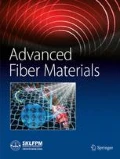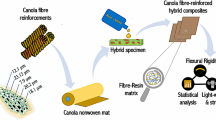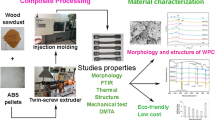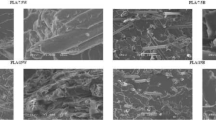Abstract
The study aims to incorporate cellulosic canola (Brassica napus L.) biopolymers with wood biomass to increase flexural strength more than wood fraction alone. A facile fabrication process—at ambient temperature—is employed for ease of producing two different sets of bio-composites utilizing unsaturated polyester resin: pristine composite structures of 100% wood and hybrid composite structures of a canola-wood blend. The curing process is accompanied by methyl ethyl ketone peroxide (MEKP). Besides the lightweight feature, the hybrid composite structures exhibit maximum flexural strength up to 59.6 and 89.58 MPa at 2.5 and 5% fibre polymer fraction, outperforming the pristine wood composites (49.25 MPa). Also, the bending behaviours of the composite structures are illustrated by the load–deflection curves and the associated SEM micrographs display their fractured and debonded surface at the cross-section. The novel canola fibre benefits from its inherent hollow architecture, facilitating an excellent strength to weight ratio for the thermoset composites. Interestingly, canola displays a fibre diameter and density of 79.80 (± 41.31) μm and 1.34 (± 0.0014) g/cc, contributing effectively towards the flexure performance and high packing density. The breaking tenacity (13.31 ± 4.59 g-force/tex) and tensile strength (174.93 ± 60.29) of canola fibres are comparable to other bast fibres. The synergy among fibre diameters, density and breaking tenacity creates a good interphase to successfully transfer the external compressive load from the resin matrix to the fibres. Further, the two-parameter Weibull distribution model is applied for predicting the failure and reliability probability of composite specimens against a wide range of compressive loads. Finally, prioritized SWOT factors have been summarized associated with the prospects and key challenges of canola biopolymers—an attempt to strategize the planning and decision-making process for a potential business environment. The introduction of canola into the plastic industries would ultimately promote the application of sustainable biopolymers in diverse grounds including the interior panels for aerospace, automotive, and furniture industries.
Graphic Abstract











Similar content being viewed by others
Availability of Data and Materials
All data generated or analyzed during this study are included in this article.
References
Zhu G, Sun G, Yu H, et al. Energy absorption of metal, composite and metal/composite hybrid structures under oblique crushing loading. Int J Mech Sci. 2018;135:458–83. https://doi.org/10.1016/j.ijmecsci.2017.11.017.
Sun G, Li S, Li G, Li Q. On crashing behaviors of aluminium/CFRP tubes subjected to axial and oblique loading: an experimental study. Compos Part B Eng. 2018;145:47–56. https://doi.org/10.1016/j.compositesb.2018.02.001.
Zhu G, Sun G, Li G, et al. Modeling for CFRP structures subjected to quasi-static crushing. Compos Struct. 2018;184:41–55. https://doi.org/10.1016/j.compstruct.2017.09.001.
Sun G, Tong S, Chen D, et al. Mechanical properties of hybrid composites reinforced by carbon and basalt fibers. Int J Mech Sci. 2018;148:636–51. https://doi.org/10.1016/j.ijmecsci.2018.08.007.
de Paiva JMF, dos Santos ADN, Rezende MC. Mechanical and morphological characterizations of carbon fiber fabric reinforced epoxy composites used in aeronautical field. Mater Res. 2009;12:367–74. https://doi.org/10.1590/S1516-14392009000300019.
Zhang K, Shi D, Wang W, Wang Q. Mechanical characterization of hybrid lattice-to-steel joint with pyramidal CFRP truss for marine application. Compos Struct. 2017;160:1198–204. https://doi.org/10.1016/j.compstruct.2016.11.005.
Chen D, Sun G, Meng M, et al. Residual crashworthiness of CFRP structures with pre-impact damage—an experimental and numerical study. Int J Mech Sci. 2018;149:122–35. https://doi.org/10.1016/j.ijmecsci.2018.08.030.
Zainudin ES, Yan LH, Haniffah WH, et al. Effect of coir fiber loading on mechanical and morphological properties of oil palm fibers reinforced polypropylene composites. Polym Compos. 2014;35:1418–25. https://doi.org/10.1002/pc.22794.
Gupta M, Singh R. PLA-coated sisal fibre-reinforced polyester composite: water absorption, static and dynamic mechanical properties. J Compos Mater. 2019;53:65–72. https://doi.org/10.1177/0021998318780227.
Abdulkareem S, Adeniyi A. Production of particle boards using polystyrene and bamboo wastes. Niger J Technol. 2017. https://doi.org/10.4314/njt.v36i3.18.
Adeniyi AG, Ighalo JO, Onifade DV. Banana and plantain fiber-reinforced polymer composites. J Polym Eng. 2019;39:597–611. https://doi.org/10.1515/polyeng-2019-0085.
Hassan A, Rafiq MIM, Ariffin MIZ. Improving thermal and mechanical properties of injection moulded Kenaf fibre-reinforced polyhydroxy-butyrate composites through fibre surface treatment. BioResources. 2019; 14
Wang X, Chang L, Shi X, Wang L. Effect of hot-alkali treatment on the structure composition of jute fabrics and mechanical properties of laminated composites. Materials (Basel). 2019;12:1386. https://doi.org/10.3390/ma12091386.
Abdulkareem SA, Adeniyi AG. Tensile and water absorbing properties of natural fibre reinforced plastic composites from waste polystyrene and rice husk. ABUAD J Eng Res Dev. 2018; 1
Arifuzzaman Khan GM, Alam Shams MS, Kabir MR, et al. Influence of chemical treatment on the properties of banana stem fiber and banana stem fiber/coir hybrid fiber reinforced maleic anhydride grafted polypropylene/low-density polyethylene composites. J Appl Polym Sci. 2013;128:1020–9. https://doi.org/10.1002/app.38197.
Shuvo II, Rahman M, Vahora T, et al. Producing light-weight bast fibers from canola biomass for technical textiles. Text Res J. 2019;90:1311–25. https://doi.org/10.1177/0040517519886636.
Shuvo II, Rahman M, Duncan R, et al. A new generation of textile fibre from canola biomass and the impact of cultivar on fibre quality. In: Integrating Design with Sustainable Technology, at The 91st Textile Institute World Conference (TIWC). Textile Institute, Leeds (2018)
Shuvo II. A holistic decision-making approach for identifying influential parameters affecting sustainable production process of canola bast fibres and predicting end-use textile choice using principal component analysis (PCA). Heliyon. 2021;7: e06235. https://doi.org/10.1016/j.heliyon.2021.e06235.
Shuvo II, DuCharme S. Inter-comparison of two instrumental test methods for diameter analysis of fibre materials: scope and challenges. J Inst Eng Ser E. 2021. https://doi.org/10.1007/s40034-021-00206-4.
Shuvo II. Fibre attributes and mapping the cultivar influence of different industrial cellulosic crops (cotton, hemp, flax, and canola) on textile properties. Bioresour Bioprocess. 2020;7:51. https://doi.org/10.1186/s40643-020-00339-1.
Ary Subagia IDG, Kim Y, Tijing LD, et al. Effect of stacking sequence on the flexural properties of hybrid composites reinforced with carbon and basalt fibers. Compos Part B Eng. 2014;58:251–8. https://doi.org/10.1016/j.compositesb.2013.10.027.
Swolfs Y, Gorbatikh L, Verpoest I. Fibre hybridisation in polymer composites: a review. Compos Part A Appl Sci Manuf. 2014;67:181–200. https://doi.org/10.1016/j.compositesa.2014.08.027.
Zhang J, Chaisombat K, He S, Wang CH. Hybrid composite laminates reinforced with glass/carbon woven fabrics for lightweight load bearing structures. Mater Des. 2012;36:75–80. https://doi.org/10.1016/j.matdes.2011.11.006.
Yusoff RB, Takagi H, Nakagaito AN. Tensile and flexural properties of polylactic acid-based hybrid green composites reinforced by kenaf, bamboo and coir fibers. Ind Crops Prod. 2016;94:562–73. https://doi.org/10.1016/j.indcrop.2016.09.017.
Zhang L, Hu Y. Novel lignocellulosic hybrid particleboard composites made from rice straws and coir fibers. Mater Des. 2014;55:19–26. https://doi.org/10.1016/j.matdes.2013.09.066.
Islam MS, Hasbullah NAB, Hasan M, et al. Physical, mechanical and biodegradable properties of kenaf/coir hybrid fiber reinforced polymer nanocomposites. Mater Today Commun. 2015;4:69–76. https://doi.org/10.1016/j.mtcomm.2015.05.001.
Bhagat VK, Biswas S, Dehury J. Physical, mechanical, and water absorption behavior of coir/glass fiber reinforced epoxy based hybrid composites. Polym Compos. 2014;35:925–30. https://doi.org/10.1002/pc.22736.
Papadopoulos AN, Hague JR. The potential for using flax (Linum usitatissimum L.) shiv as a lignocellulosic raw material for particleboard. Ind Crops Prod. 2003;17:143–7. https://doi.org/10.1016/S0926-6690(02)00094-8.
Han G, Zhang C, Zhang D, et al. Upgrading of urea formaldehyde-bonded reed and wheat straw particleboards using silane coupling agents. J Wood Sci. 1998;44:282–6. https://doi.org/10.1007/BF00581308.
Hashim R, Nadhari WNAW, Sulaiman O, et al. Characterization of raw materials and manufactured binderless particleboard from oil palm biomass. Mater Des. 2011;32:246–54. https://doi.org/10.1016/j.matdes.2010.05.059.
Kibria ASMG. Physico-mechanical comparison of urea formalde-hyde bonded particle board manufactured from jute sticks and wood of Trewia nudiflora. Ann For Res. 2012. https://doi.org/10.15287/afr.2012.69.
Guler C, Copur Y, Tascioglu C. The manufacture of particleboards using mixture of peanut hull (Arachis hypoqaea L.) and European Black pine (Pinus nigra Arnold) wood chips. Bioresour Technol. 2008;99:2893–7. https://doi.org/10.1016/j.biortech.2007.06.013.
Bektas I, Guler C, Kalaycioğlu H, et al. The manufacture of particleboards using sunflower stalks (helianthus annuus l.) and poplar wood (populus alba L.). J Compos Mater. 2005;39:467–73. https://doi.org/10.1177/0021998305047098.
Nemli G, Kırcı H, Serdar B, Ay N. Suitability of kiwi (Actinidia sinensis Planch.) prunings for particleboard manufacturing. Ind Crops Prod. 2003;17:39–46. https://doi.org/10.1016/S0926-6690(02)00057-2.
Shuvo II. Hollow canola-wood thermoset composites from concept to completion: fabrication, performance, failure and reliability analysis. SN Appl Sci. 2020;2:2087. https://doi.org/10.1007/s42452-020-03931-4.
Mohanty AK, Misra M, Drzal LT. Natural fibers, biopolymers, and biocomposites. CRC Press; 2005.
ASTM International ASTM D1445/D1445M-12, Standard test method for breaking strength and elongation of cotton fibers (Flat Bundle Method). West Conshohocken (2012)
ASTM D3410 Standard test method for compressive properties of polymer matrix composite materials with unsupported gage section by shear loading (2016)
Lochab B, Shukla S, Varma IK. Naturally occurring phenolic sources: monomers and polymers. RSC Adv. 2014;4:21712–52. https://doi.org/10.1039/C4RA00181H.
ASTM D276 Standard test methods for identification of fibers in textiles (2012)
Kozlowski R. Handbook of natural fibres, vol. 1. Cambridge: Woodhead Publishing Ltd 2012
Kozlowski R Handbook of natural fibres, vol. 2, 1st ed. Cambridge: Woodhead Publishing 2012
Gregory J. 34—Cotton yarn structure part IV—the strength of twisted yarn elements in relation to the properties of the constituent fibres. J Text Inst Trans. 1953;44:T499–514. https://doi.org/10.1080/19447025308662613.
Obukuro M, Takahashi Y, Shimizu H. Effect of diameter of glass fibers on flexural properties of fiber-reinforced composites. Dent Mater J. 2008;27:541–8. https://doi.org/10.4012/dmj.27.541.
Khorami M, Ganjian E. Comparing flexural behaviour of fibre–cement composites reinforced bagasse: wheat and eucalyptus. Constr Build Mater. 2011;25:3661–7. https://doi.org/10.1016/j.conbuildmat.2011.03.052.
Xie X, Zhou Z, Yan Y. Flexural properties and impact behaviour analysis of bamboo cellulosic fibers filled cement based composites. Constr Build Mater. 2019;220:403–14. https://doi.org/10.1016/j.conbuildmat.2019.06.029.
Chakraborty S, Kundu SP, Roy A, et al. Improvement of the mechanical properties of jute fibre reinforced cement mortar: a statistical approach. Constr Build Mater. 2013;38:776–84. https://doi.org/10.1016/j.conbuildmat.2012.09.067.
Cesar PF, Yoshimura HN, Miranda WG, et al. Relationship between fracture toughness and flexural strength in dental porcelains. J Biomed Mater Res Part B Appl Biomater. 2006;78B:265–73. https://doi.org/10.1002/jbm.b.30482.
Savastano H, Warden P, Coutts RS. Brazilian waste fibres as reinforcement for cement-based composites. Cem Concr Compos. 2000;22:379–84. https://doi.org/10.1016/S0958-9465(00)00034-2.
Chandramohan D, Presin Kumar AJ. Experimental data on the properties of natural fiber particle reinforced polymer composite material. Data Br. 2017;13:460–8. https://doi.org/10.1016/j.dib.2017.06.020.
Jawaid M, Abdul Khalil HPS, Abu Bakar A. Mechanical performance of oil palm empty fruit bunches/jute fibres reinforced epoxy hybrid composites. Mater Sci Eng A. 2010;527:7944–9. https://doi.org/10.1016/j.msea.2010.09.005.
Sature P, Mache A. Mechanical characterization and water absorption studies on jute/hemp reinforced hybrid composites. Am J Mater Sci. 2015. https://doi.org/10.5923/c.materials.201502.27.
Dineskumar P, Mukesh B, Parathwaaj K (2020) Mechanical characterization of cissus quadrangularis stem/glass fiber hybrid composites. Int Res J Eng Technol 7
Rafiquzzaman M, Islam MT, Hossain MR, et al. Fabrication and performance test of glass-bamboo fiber based industry safety helmet. Am J Mech Mater Eng. 2017. https://doi.org/10.11648/j.ajmme.20170102.13.
Lu N, Swan RH, Ferguson I. Composition, structure, and mechanical properties of hemp fiber reinforced composite with recycled high-density polyethylene matrix. J Compos Mater. 2012;46:1915–24. https://doi.org/10.1177/0021998311427778.
Graciani E, Mantič V, París F, Varna J (2016) Fiber–matrix debonding in composite materials. In: Modeling Damage, Fatigue and Failure of Composite Materials. Elsevier, pp 117–141
Johnson AC, Hayes SA, Jones FR. The role of matrix cracks and fibre/matrix debonding on the stress transfer between fibre and matrix in a single fibre fragmentation test. Compos Part A Appl Sci Manuf. 2012;43:65–72. https://doi.org/10.1016/j.compositesa.2011.09.005.
Mylsamy B, Chinnasamy V, Palaniappan SK, et al. Effect of surface treatment on the tribological properties of Coccinia Indica cellulosic fiber reinforced polymer composites. J Mater Res Technol. 2020;9:16423–34. https://doi.org/10.1016/j.jmrt.2020.11.100.
Wisnom MR. The role of delamination in failure of fibre-reinforced composites. Philos Trans R Soc A Math Phys Eng Sci. 2012;370:1850–70. https://doi.org/10.1098/rsta.2011.0441.
Mehdikhani M, Petrov NA, Straumit I, et al. The effect of voids on matrix cracking in composite laminates as revealed by combined computations at the micro- and meso-scales. Compos Part A Appl Sci Manuf. 2019;117:180–92. https://doi.org/10.1016/j.compositesa.2018.11.009.
Beura S, Thatoi D, Chakraverty A, Mohanty U. Impact of the ambiance on GFRP composites and role of some inherent factors: a review report. J Reinf Plast Compos. 2018;37:533–47. https://doi.org/10.1177/0731684418754359.
Berglund J, Mikkelsen D, Flanagan BM, et al. Wood hemicelluloses exert distinct biomechanical contributions to cellulose fibrillar networks. Nat Commun. 2020;11:4692. https://doi.org/10.1038/s41467-020-18390-z.
Roy A, Chakraborty S, Kundu SP, et al. Improvement in mechanical properties of jute fibres through mild alkali treatment as demonstrated by utilisation of the Weibull distribution model. Bioresour Technol. 2012;107:222–8. https://doi.org/10.1016/j.biortech.2011.11.073.
Sayeed MMA, Paharia A. Optimisation of the surface treatment of jute fibres for natural fibre reinforced polymer composites using Weibull analysis. J Text Inst. 2019;110:1588–95. https://doi.org/10.1080/00405000.2019.1610998.
Chakma K (2019) Extraction efficiency, quality and characterization of Typha latifolia L. fibres for textile applications. University of Manitoba
Acknowledgements
The authors like to thank Dr. Mashiur Rahman for the technical guidelines.
Funding
The work was supported by MITACS Canada, Composites Innovation Centre (CIC Engineering, Canada), and the University of Manitoba Graduate Fellowship.
Author information
Authors and Affiliations
Contributions
IS wrote the manuscript, designed the study, fabricated the composites, conducted all the mechanical experiments, and performed the statistical data analysis. MdS and LK participated in the morphological experiments. MdSH helped IS to draft the morphological study.
Corresponding author
Ethics declarations
Conflict of Interests
The authors state that there are no conflicts of interest to disclose.
Ethics Approval and Consent to Participate
This research does not contain any studies on human participants or animals performed by the author.
Consent for Publication
I, Ikra Iftekhar Shuvo (IIS), the author, hereby declare that it is my study, and I developed the manuscript titled ‘Flexural strength and load–deflection behaviour of hybrid thermoset composites of wood & canola biopolymers’. The study was conducted at the University of Manitoba and Composites Innovation Centre (CIC Engineering, Canada).
Rights and permissions
About this article
Cite this article
Shuvo, I.I., Hoque, M.S., Shadhin, M. et al. Flexural Strength and Load–Deflection Behaviour of Hybrid Thermoset Composites of Wood and Canola Biopolymers. Adv. Fiber Mater. 3, 331–346 (2021). https://doi.org/10.1007/s42765-021-00089-5
Received:
Accepted:
Published:
Issue Date:
DOI: https://doi.org/10.1007/s42765-021-00089-5




